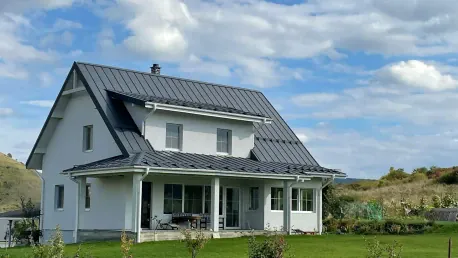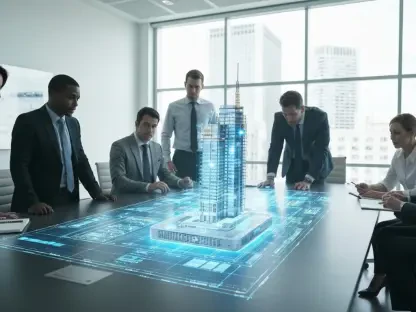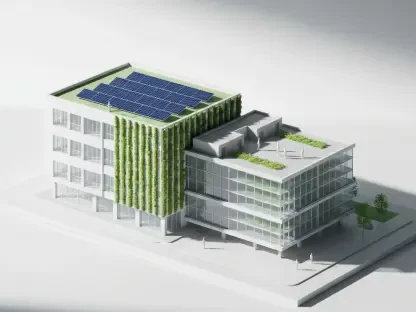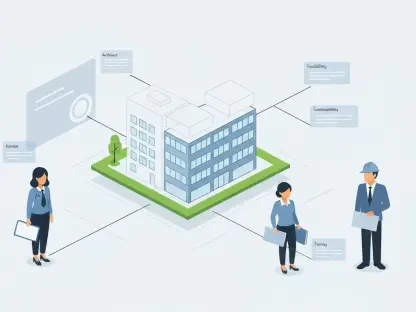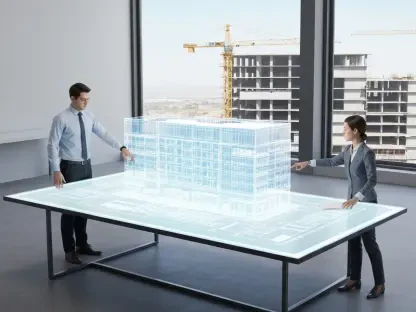The homebuilding industry is in a period of significant transformation, influenced by key factors such as affordability, sustainability, and technological advancements. In 2025, home construction is being reshaped to meet these evolving demands, leading to smaller, smarter, and more sustainable homes.
Downsizing for Affordability
Rising Costs and Smaller Homes
The increasing expense of homeownership has led to a trend of downsizing, with new single-family homes becoming smaller. According to data from the National Association of Home Builders (NAHB), the average size of new homes dropped to 2,411 square feet in 2023, marking a significant decrease. This move reflects a broader shift towards more efficient use of living space amidst the rising costs associated with homeownership.
Factors such as higher land prices, increased building material costs, and labor shortages have all contributed to the trend of constructing smaller homes. This downsizing allows prospective homeowners to enter the market without facing exorbitant prices. The decline in home size also correlates with changing lifestyle preferences, where homeowners prioritize functionality and efficient space usage over expansive layouts. The industry has had to adapt to meet these evolving consumer preferences and economic realities, revealing that smaller homes are not just a passing trend but a necessary evolution in the housing market.
Market Adaptation
Homebuilders like D.R. Horton are adapting to this demand by reducing the average home size to attract budget-conscious buyers, resulting in market success. Recognizing the need for affordable housing options, D.R. Horton has adjusted its business strategy accordingly, demonstrating a keen understanding of the market’s pulse. By offering smaller, well-designed homes, they have managed to appeal to first-time buyers and those looking to downsize, creating a broader range of opportunities within the housing market.
This strategy has proven to be effective, allowing D.R. Horton to not only retain but also expand its customer base. The company’s success underscores the importance of flexibility and responsiveness in the homebuilding industry. By introducing smaller homes with practical layouts and modern amenities, builders are effectively aligning product offerings with current consumer needs, thereby driving sales and satisfaction. This approach highlights the interconnectedness of affordability and innovative design in addressing the demands of the contemporary housing market.
Building for Natural Disasters
Increased Extreme Weather
The growing severity of natural disasters has necessitated homes that can withstand such events. According to the National Centers for Environmental Information (NCEI), 2024 saw 27 climate and weather-related disasters in the U.S., each causing significant damage. This alarming trend has spurred a move towards building homes that can resist extreme weather conditions, ensuring the safety and durability of the structures.
To address these concerns, builders are increasingly turning to resilient design and durable materials, which offer enhanced protection against the elements. The use of fire-resistant siding, non-combustible roofing, and fortified concrete or steel framing provides a robust defense against natural disasters. Recognizing regional variations in weather risks, builders are innovating with localized solutions to ensure homes can withstand specific environmental challenges, such as impact-resistant windows in hurricane-prone areas or reinforced foundations in earthquake zones.
Innovative Solutions
Companies like Re-Structure Group (RSG) are developing advanced materials that offer increased protection, such as fire-resistant building panels. RSG’s 3-D building panel system represents a significant leap forward in resilient construction. These panels can withstand the devastating forces of hurricanes, earthquakes, and other natural disasters, offering a safer alternative to traditional wood framing. By integrating these advanced materials into home construction, builders can significantly enhance the durability and safety of new homes.
This innovation is not only a response to immediate environmental challenges but also a proactive approach to future-proofing home construction. Although these materials are not yet standard, their adoption is expected to grow as their benefits become more widely recognized. By leading the charge in disaster-resistant building practices, companies like RSG are setting new benchmarks for the industry. This approach ensures that homes not only meet current safety standards but also provide long-term resilience against an increasingly unpredictable climate.
Modular and Prefabricated Construction
Efficiency and Speed
The demand for faster, efficient construction has led to the rise of modular and prefabricated methods, significantly accelerating build schedules. Modular construction, which involves pre-fabricating sections of a home in a factory and then assembling them on site, offers substantial advantages over traditional building techniques. According to a report by McKinsey & Company, this method can shorten construction timelines by 20-50%, allowing homeowners to move in more quickly.
Beyond speed, modular construction also improves quality control, as the factory setting enables better oversight and reduced defects. Offsite manufacturing minimizes material waste, which is both environmentally friendly and cost-effective. This approach is particularly advantageous in disaster recovery scenarios, where quick rebuilding is essential. By leveraging the efficiencies of modular construction, builders can provide rapid, high-quality housing solutions to those affected by natural disasters, helping families return to normalcy sooner.
Industry Adoption
Major homebuilders, including Lennar, are investing in modular construction to enhance resilience and reduce material waste. Lennar’s acquisition of the modular building startup Veev signifies the company’s commitment to this innovative approach. By integrating modular construction into its portfolio, Lennar aims to capitalize on the method’s rapid build times and sustainability benefits. This strategic investment highlights the growing acceptance and incorporation of modular techniques within mainstream homebuilding.
The global modular construction market is expected to grow significantly, reflecting a broader shift towards efficiency and sustainability in the industry. As builders like Lennar adopt and refine these methods, the benefits—including reduced waste, faster project timelines, and consistent quality—are likely to become more pronounced. This trend not only addresses immediate construction needs but also aligns with long-term industry goals of sustainability and resilience. Hence, modular and prefabricated constructions are set to play a crucial role in shaping the future of homebuilding.
Sustainable Building Practices
Growing Interest in Eco-Friendly Homes
Sustainability is at the forefront of homebuilding, with an increasing number of builders adopting green building practices to meet consumer demand. The Green & Resilient Single-Family Homes report for 2024 indicated that nearly one-quarter of builders prioritized green building criteria in their projects, reflecting a significant shift from previous years. This growing interest in eco-friendly homes stems from both regulatory pressures and consumer preferences for sustainable living.
Environmental concerns, such as climate change and resource conservation, are driving this shift towards green construction. Homebuilders are increasingly incorporating energy-efficient designs, renewable energy sources, and sustainable materials into their projects. Solar panels, high-efficiency HVAC systems, and water-saving fixtures are becoming standard features in new homes. These practices not only reduce the ecological footprint of the homes but also appeal to environmentally conscious buyers seeking to minimize their impact on the planet.
Long-Term Benefits
Eco-friendly materials and energy-efficient designs, though costly upfront, provide long-term savings on utilities and maintenance. The initial investment in sustainable building practices is offset by the reduced operating costs over the home’s lifespan. For instance, homes designed to maximize energy efficiency can significantly lower heating and cooling expenses. Additionally, sustainable materials often require less maintenance and have longer lifespans, resulting in reduced repair and replacement costs.
The long-term benefits of green homes extend beyond financial savings. They also contribute to healthier living environments by improving indoor air quality and reducing exposure to harmful chemicals. These advantages make sustainable homes attractive to a wide range of buyers, including those prioritizing both economic and health considerations. As awareness of these benefits grows, the demand for eco-friendly homes is expected to increase, further propelling the adoption of sustainable practices in the homebuilding industry.
Integration of Smart Home Technology
AI-Powered Features
Smart home technology is becoming a standard expectation, with the market for AI-driven home automation features growing rapidly. As reported by Statista, the global smart home market is poised to surpass $170 billion in revenue by 2025, marking a significant milestone in technological integration within homes. Homeowners are increasingly looking for AI-powered systems that enhance convenience, security, and efficiency.
Younger generations, in particular, are driving this demand, having grown accustomed to the seamless integration of technology in their daily lives. Advanced systems like Control4 offer centralized control over various smart home features, including lighting, security, and entertainment. These AI-powered solutions can also learn user preferences and automate routines, creating a personalized living experience. As technology continues to evolve, the capabilities of smart homes are expected to expand, providing even greater benefits to homeowners.
Enhancing Marketability
Homebuilders are incorporating systems like Control4 to appeal to tech-savvy buyers and enhance the long-term value of homes. The integration of smart technology not only meets current consumer demands but also future-proofs homes by aligning them with ongoing advancements. This strategic approach differentiates new constructions in a competitive market, making them more attractive to buyers who prioritize technological convenience and innovation.
The adoption of smart home technology is also enhancing homebuilders’ operational efficiency. For instance, companies like EarthCam have developed AI-powered cameras that monitor construction sites, ensuring worker safety and compliance with protocols. These innovations improve construction management and contribute to building safer, more reliable homes. As smart home technology becomes more integral to the homebuilding process, its impact on marketability and construction efficiency will continue to grow, shaping the future of the industry.
Streamlined Homebuying with Embedded Insurance
Simplifying the Process
Embedded home insurance is gaining popularity, simplifying the homebuying process by integrating insurance directly into the purchase. This approach eliminates the need for buyers to secure coverage separately, reducing closing delays and ensuring seamless transition from construction to homeownership. By providing insurance as part of the home purchase, builders can enhance the overall buying experience, offering a one-stop solution that increases convenience and reduces stress for buyers.
This streamlined process builds trust between builders and buyers, as it demonstrates a commitment to a hassle-free transaction. By addressing potential coverage gaps from the outset, embedded insurance ensures that new homeowners are adequately protected from day one. This integration is particularly beneficial in markets where buyers may be unfamiliar with the nuances of home insurance, as it removes barriers and simplifies decision-making.
Boosting Buyer Confidence
By reducing closing delays and ensuring seamless coverage, builders can enhance buyer satisfaction and trust. This proactive approach to integrating insurance into the homebuying process addresses a common pain point, providing peace of mind for buyers. The assurance that their new home is protected from the moment they step through the door adds considerable value to the buying experience.
Moreover, this trend underscores the evolving nature of the homebuilding industry, where added-value services are becoming increasingly important. By offering embedded insurance, builders can differentiate their offerings in a competitive market, positioning themselves as customer-centric and forward-thinking. This innovation not only improves the immediate purchasing process but also has the potential to build long-term loyalty and satisfaction among homeowners.
Anticipating Future Developments
The homebuilding industry is undergoing a significant transformation, driven by major factors like affordability, sustainability, and technological advancements. By 2025, home construction trends are shifting to align with these evolving demands, resulting in homes that are smaller, smarter, and more sustainable. Builders and developers are increasingly focusing on creating living spaces that not only cost less but also minimize environmental impact. Innovation in construction technology, such as the use of eco-friendly materials and smart home systems, is playing a crucial role in this shift. These advancements are making it possible to build homes that are energy-efficient, environmentally friendly, and equipped with the latest technology to enhance the quality of life for residents. As a result, new homes are being designed to maximize space and functionality while reducing their carbon footprint. This period of change in the homebuilding industry represents a move towards more responsible and future-oriented housing solutions that meet the needs of today’s homeowners and contribute to a more sustainable world.
